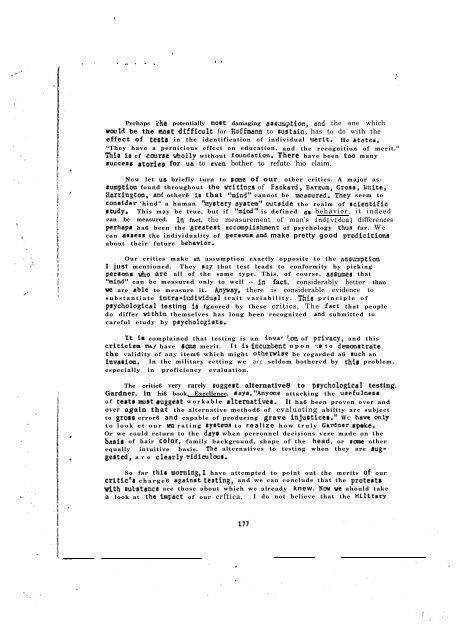Technical Report - International Military Testing Association
Technical Report - International Military Testing Association
Technical Report - International Military Testing Association
Create successful ePaper yourself
Turn your PDF publications into a flip-book with our unique Google optimized e-Paper software.
.<br />
. . . _. . - ._<br />
.<br />
. .<br />
Perhaps tha potentially mo6t damaging a66w$ion, rind the one which<br />
would be the mont difffcvlt for R0ffraan.n to 6u6tain, has to do with the<br />
effect of teatrr in the identification of individual mertt, He 6tate6,<br />
“They have a pernicious effect on education, and the recognition of merit.”<br />
Thi6 io cf cour6e -wholly without fcwundation. There have been too many<br />
6ucce66 6torie6 for u8 to even bother to refute hio claim.<br />
Now let u6 briefly turn to 6ome of our other critics. A major as-<br />
6umption found throughout the =fCfnpe of Packed, Barrum, Grose, tatlFte,<br />
Xarringtm, ard other6 i6 that “mind” cannot be meaeured. Tbcy seem to<br />
Consider ‘hind” a human “mystery 6y6tem” outeide the realm of rcientific<br />
otudy. This may be true, but if “Axi” is defined aa behavior, it indeed<br />
can be measured. In fact, the measurement of man’s fndividual differences<br />
perhapr ha6 been the greate6t sccwplishment of psychology thus far. We<br />
can anaeas the individuality of persons rind make pretty good predicitions<br />
about their future behevior.<br />
Our critics make tin assumption exactly opposite to the aerrtqtion<br />
I just mentioned. They se+- that test leads to conformity by picking<br />
perecmo who are all of the same type. This, of course, as6ume6 that<br />
“mind” can be measured only to well -- in fact, considerably better than<br />
we are able to measure it. Anyvay, there is considerable evidence to<br />
substantiate intra-individual trait variability. Thfa principle of<br />
p6ychologlcal testing 16 fgnored by these critics, The feet that people<br />
do differ vithfn themselves has long been recognized srnd submitted to<br />
careful etudy by peychologfste.<br />
It i6 complained that testing is an inva< ?on of prlvocy, and this<br />
criticicm m.6~ have 6ai~e merit. It i6 incumbent upon ‘:6 to demonstrate<br />
the validity of any item6 which might otherxiae be regarded a6 such an<br />
invarion. In the military eetting we arc seldom bothered by rhfs problem,<br />
especially in proficiency evaluation.<br />
The critic6 very rarely euggert alternative8 to p6yChOlOgiCal testing.<br />
Gardner, in hi6 book, Excellence, 6aye,“Anyone attacking the ueefulnerrr<br />
of te6t6 6w6t suggeet workable elternatlves. It ha6 been proven over and<br />
over again that the alternative method6 of evaluating ability arc subject<br />
to groso error6 and capable of producing grave injucticcr.” WC have only<br />
to look et our = rating ryrtem6 to realize how truly Gardaer rpoke.<br />
Or we could return to the day6 when perronnel decisions vere made on the<br />
baeir of hair color, family background, shape of the head, or sate other<br />
equally intuitive basis. The alternatives to testing when they are euggeeted,<br />
are cIearly rldfculous.<br />
So far thir morning,1 have attempted to point out the merits of our<br />
crltlc’6 charge6 agafnat testing, and we can conclude that the proterts<br />
tith oubatance are those about which we already knew. Hov we ahould take<br />
a look at the impact of our crftica. I do not believe that the Mllttary









